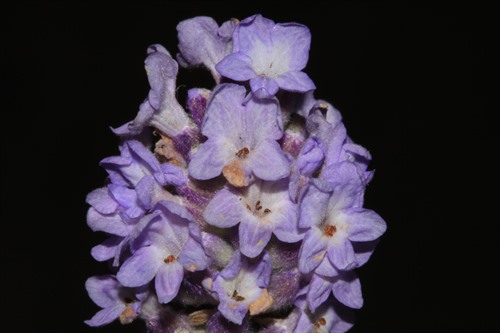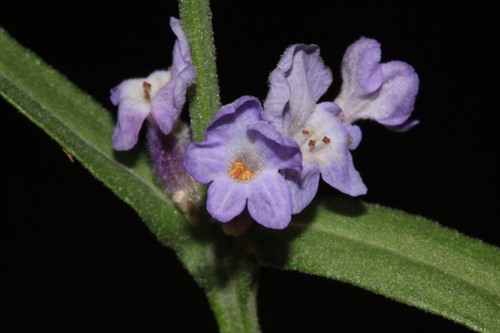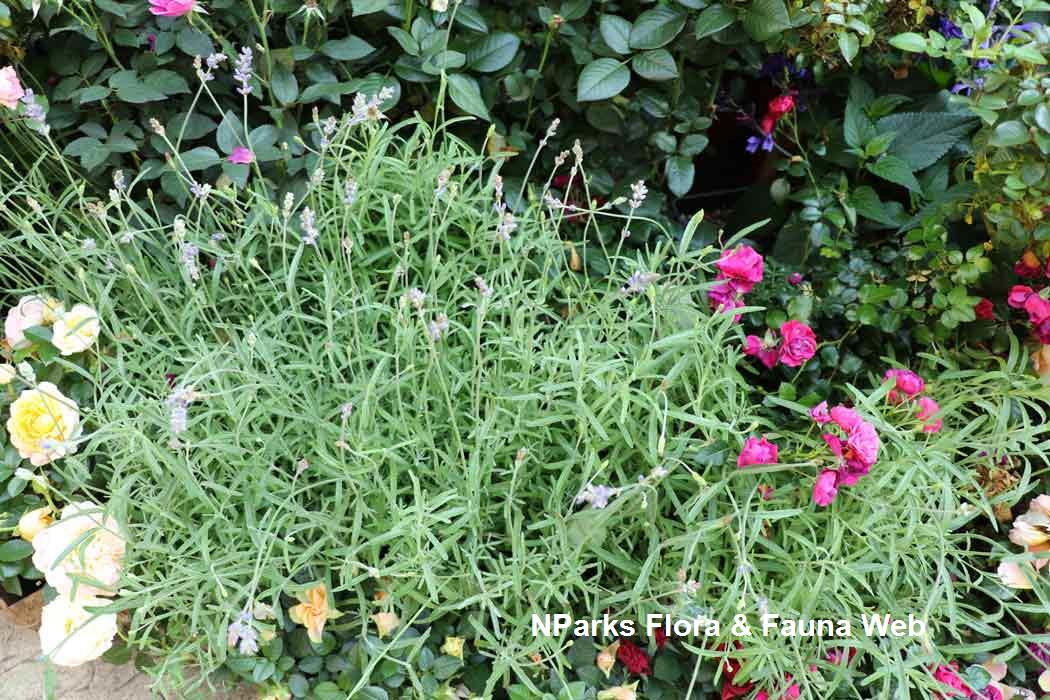
Back
Lavandula angustifolia Mill.
| Family Name: | Lamiaceae (Labiatae) |
| Common Name: | English Lavender, 薰衣草 |
Name
Classifications and Characteristics
| Plant Division | Angiosperms (Flowering Seed Plants) (Dicotyledon) |
|---|---|
| Plant Growth Form | Shrub |
| Lifespan (in Singapore) | Perennial |
| Mode of Nutrition | Autotrophic |
| Plant Shape | Shrubby |
| Maximum Height | 45 cm |
Biogeography
| Native Distribution | Spain to Italy |
|---|---|
| Native Habitat | Terrestrial |
| Preferred Climate Zone | Mediterranean |
| Local Conservation Status | Non-native (Horticultural / Cultivated Only) |
Description and Ethnobotany
| Growth Form | Perennial herb up to 45 cm tall. |
|---|---|
| Foliage | Silvery leaves are narrowly linear (1.7-5 cm long, 2-5 mm wide) with flowering shoots having larger, more widely spaced leaves than leafy shoots. The leaf edge is smooth with a pointed tip, wedge-shaped base and a very short petiole (leaf stalk). They are tomentose, being covered by a dense mat of soft hairs. |
| Flowers | Tubular, 2-lipped flowers are arranged in a whorl-like pattern in clusters of 6-10 along a spike inflorescence. |
| Fruit | Tiny fruits are dry, indehiscent and known as nutlets. |
| Cultivation | This species is prone to root rot and requires well-draining soil. It also needs good air circulation. |
| Ethnobotanical Uses | Edible Plant Parts : Edible Leaves, Edible Flowers Food (Herb or Spice): The flowers have a sweet, citrus-like flavor. They are used in salads, stews, breads and sauces. Since they have a strong flavour, it is better to add smaller amounts to dishes. The leaves and flowering spikes can be used as a replacement for rosemary. Others: It is added to potpourri and perfumes. |
Landscaping Features
| Desirable Plant Features | Ornamental Flowers, Fragrant (Flowers) |
|---|---|
| Landscape Uses | Small Gardens |
Plant Care and Propagation
| Light Preference | Full Sun |
|---|---|
| Water Preference | Moderate Water |
| Rootzone Tolerance | Well-Drained Soils |
| Propagation Method | Seed, Stem Cutting, Division |
| Propagation Method Remarks | Preferred method of propagation is by rooting stem cuttings. |
Foliar
| Mature Foliage Colour(s) | Silver / Grey |
|---|---|
| Mature Foliage Texture(s) | Velvety / Furry / Tomentose |
| Foliar Type | Simple / Unifoliate |
| Foliar Attachment to Stem | Petiolate |
| Foliar Shape(s) | Non-Palm Foliage (Linear) |
| Foliar Venation | Pinnate / Net |
| Foliar Margin | Entire |
| Foliar Apex - Tip | Acute |
| Foliar Base | Attenuate |
| Typical Foliar Area | Microphyll ( 2.25cm2 - 20.25 cm2 ) |
Floral (Angiosperm)
| Flower & Plant Sexuality | Bisexual Flowers |
| Flower Colour(s) | Purple, Blue |
|---|---|
| Flower Texture(s) | Smooth |
| Flower Grouping | Cluster / Inflorescence |
| Flower Location | Terminal |
| Flower Symmetry | Asymmetrical |
| Individual Flower Shape | Tubular |
| Inflorescence Type | Spike, Verticel |
| Flowering Habit | Polycarpic |
Fruit, Seed and Spore
| Mature Fruit Texture(s) | Smooth |
|---|---|
| Fruit Classification | Simple Fruit |
| Fruit Type | Indehiscent Dry Fruit , Nut / Nutlet |
Image Repository
Others
| Master ID | 31894 |
|---|---|
| Species ID | 6295 |
| Flora Disclaimer | The information in this website has been compiled from reliable sources, such as reference works on medicinal plants. It is not a substitute for medical advice or treatment and NParks does not purport to provide any medical advice. Readers should always consult his/her physician before using or consuming a plant for medicinal purposes. |











